Better highway infrastructure design is needed to accommodate higher loads, much of it related to construction equipment, said president and CEO Dave Earle.
While container loads are the same height, construction equipment and loads related to construction are growing.
ÔÇťThe equipment is getting bigger and the infrastructure is the issue,ÔÇŁ he said as large projects currently near completion.
ÔÇťWhat we are seeing is the big moves because of the decommissioning of Site C and the Coastal pipeline is almost done. The big stuff is winding down and equipment is being demobilized and relocated.ÔÇŁ
Earle said highway construction needs to be modernized to accommodate todayÔÇÖs larger loads and over height vehicle detection systems are available that can warn a driver his load wonÔÇÖt fit under a structure.
But, these systems need to be combined with a highway exit design that can accommodate trucks hauling over height loads.
ÔÇťThe key is to get around it,ÔÇŁ he said.
Earle said he is pleased the has been meeting with the trucking industry.
The ministry said via email it is seeking solutions.   
ÔÇťEngineers at the Ministry of Transportation and Infrastructure are looking at other jurisdictions in North America to see what is in place to protect critical highway infrastructure from collisions ÔÇô recognizing that not every solution is appropriate for B.C.ÔÇÖs climate,ÔÇŁ it said.┬á
Overpass heights outdated
B.C. had 16 strikes by trucks in 2022 and 34 (six involved excavators arms not lowered) since the end of 2021, leading to new stiffer fines and regulations.
The fine for hitting an overpass has been raised to $575 from $115. Dump-style vehicles must have in-cab warning devices by June 1, 2024, alerting drivers to a raised dump box with non-compliance fines set at $598.
Many overpass heights are simply outdated. They were built at a time when it was not anticipated higher loads would be hauled, Earle said, adding the standard overpass is 4.7 metres.
The ministry now has a five-metre minimum requirement for new construction. Some structures are higher such as the new Glover Road Crossing at Highway 1. New structures as part of the will have a height clearance of 5.2 metres. Pedestrian structures and other light structures will maintain a minimum vertical clearance of 5.5 metres.
What other provinces are doing
Other western Canadian provinces have raised heights as well.  
In Saskatchewan, the two new $25 million Highway 6 and Ring Road overpasses in Regina, now under construction, are raised to a clearance height of 5.2 metres to accommodate higher loads and replacing older 4.7 metre clearance structures.  
In 2022, the ministry increased its Highway 11/Highway 6 overpass clearance on ReginaÔÇÖs north side to 5.2 metres. The ministry is currently designing a Highway 2/Trans-║┌┴¤│ď╣¤═° Highway 1 overpass at Moose Jaw with higher clearance structures of 5.2 metres.
But, building overpasses higher are only part of the solution.
ÔÇťYou can never build them high enough,ÔÇŁ said Earle.
Higher overpasses also require longer raised approaches, which is not always feasible.
Alberta is the province that is leading Western ║┌┴¤│ď╣¤═° in installing warning systems and designing highways to accommodate over height truck loads. The province began installing early warning systems more than a decade ago as Alberta has large equipment and installations trucked in for wind farms, construction, oilfields and forestry. ┬á
The province also has had an established high-load routing through the province, said CEO Ron Glen.
based in Virginia, has Canadian detection systems in place and works with SaskatoonÔÇÖs International Road Dynamics Inc.
ÔÇťWe have installations in B.C., Alberta, Quebec, Ontario and peppered throughout ║┌┴¤│ď╣¤═°,ÔÇŁ said TriggÔÇÖs chief technical officer Sam Slade.
Four years ago, Trigg worked with Edmonton-based RGM Contracting to install eight of its units in Alberta, which has 11 such warning systems in place.
The Trigg system is a powered roadway system emitting an invisible light beam. When over height vehicles break the beam, a warning ÔÇô either an audible or visual sign ÔÇô tells the driver to exit.
Signs can also be installed to give redirection.  
ÔÇťThey know if they proceed there will be an incident,ÔÇŁ Slade said. ┬á
Slade said the systems can be configured to capture a license plate number as well as some strikes are not sufficient to cause the driver to stop but damage results.
A U.S. transportation study of a variety of early-warning systems found they could be used for alerting construction workers working near or around overpasses that an over height vehicle was approaching.
TriggÔÇÖs system, designed and manufactured in house, consists of the components shipped to the buyer and installed by a local outdoors electrical contractor. The entry level pricing is from $8,000 to $25,000 in U.S. dollars, Slade said. ┬á
The price pales in comparison to repair costs.
SaskatchewanÔÇÖs ministry found damage from hits can range from $100,000 to $2 million. ┬á
B.C.ÔÇÖs ministry also reported damages, in incidents as recent as December 2023, resulting in $2 million damages.



Recent Comments
comments for this post are closed